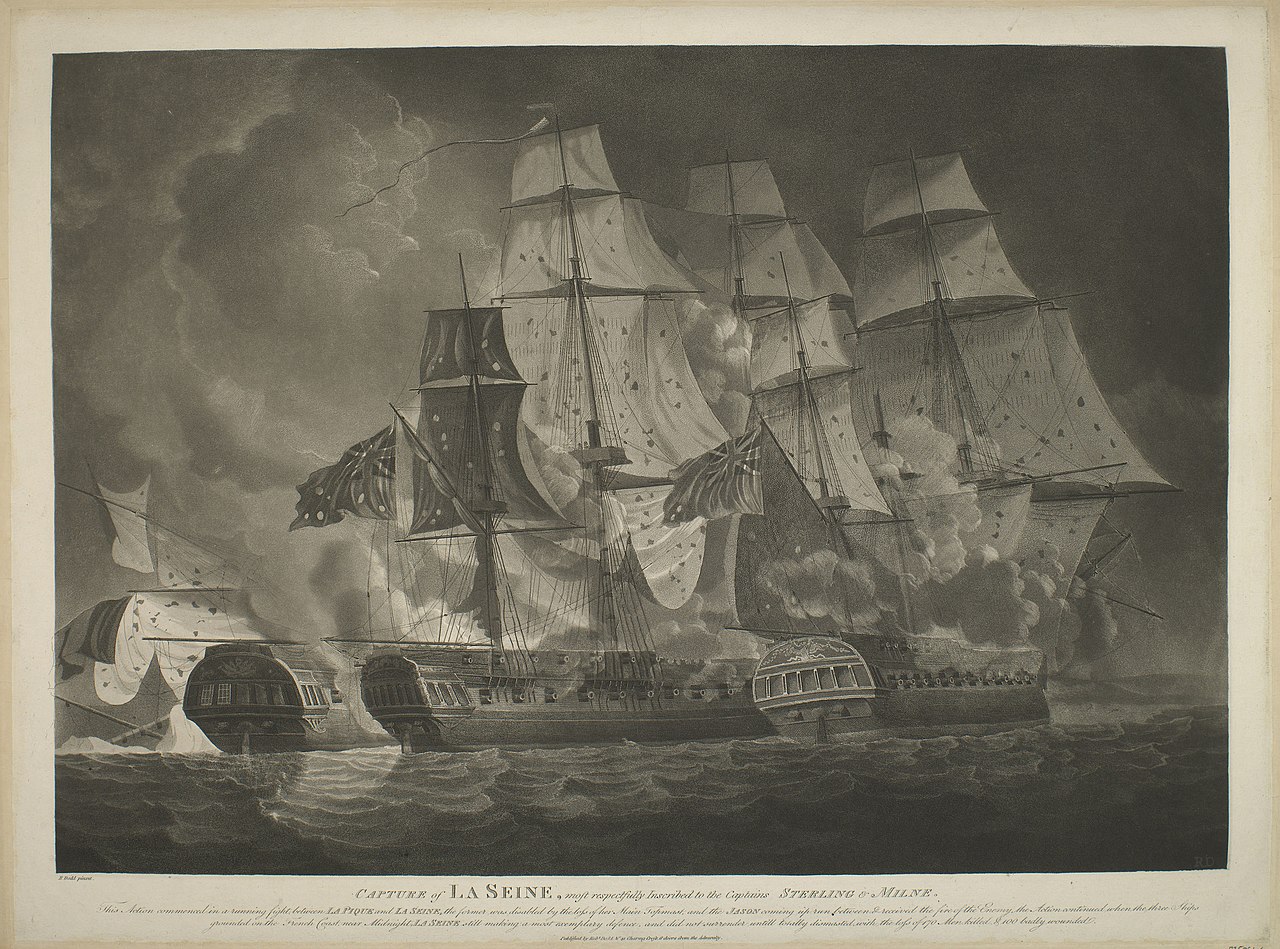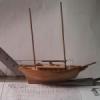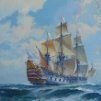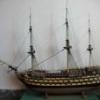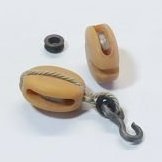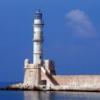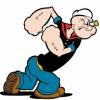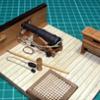-
Posts
2,245 -
Joined
-
Last visited
Reputation Activity
-
 Beef Wellington got a reaction from Bluto 1790 in Where are my pumps?
Beef Wellington got a reaction from Bluto 1790 in Where are my pumps?
Hi Jim, your analysis seems sound. The pumps would all have been contained within the well around the mainmast, and would need to be forward of the chain pumps and aft of the pillar with the rhodings for the Axeltree. Any other location would interfere with the working of the fore and aft winches when installed. The only remaining question is why they are missing from your reference material, and that's a mystery. I would include them if I were in your shoes.
As to the number of chain pumps, I can only speculate its down to the size of the ship. There is ample evidence for there being 4 on 1st and 2nd rate ships of the line, and similarly 2 on smaller 5th rates, so logically there must be a cross over point wherever that is. Don't think I've seen any discussion on that, but 2 doesn't seem unreasonable on a 50 gun 4th rate.
-
 Beef Wellington got a reaction from mtaylor in Where are my pumps?
Beef Wellington got a reaction from mtaylor in Where are my pumps?
According to TFFM the elm tree pumps also terminate in the bilge, very similar to the low point of the chain pumps. Your identification of the placement for the elmtree pumps is consistent in the photo above.
-
 Beef Wellington reacted to SJSoane in HMS Bellona 1760 by SJSoane - Scale 1:64 - English 74-gun - as designed
Beef Wellington reacted to SJSoane in HMS Bellona 1760 by SJSoane - Scale 1:64 - English 74-gun - as designed
Thanks, Paul, my wife is starting to get nervous about how long it is taking me to finish this project. She doesn't know what to do with it if I pass on before it is done, and I think she is looking forward to putting my ashes on it and floating it out into the lake on fire. She hasn't noticed that it has no planking below the waterline...So I thought I better pick up the pace a little with some shortcuts.
And thanks, Grant, I was afraid the secret would get out...☺️
We had a snowstorm last night, plus nowhere else to go while sheltering in place, so I got more done today.
I was finally able to trim the planking back to the lower and upper counters, turning the hull upside down so I could see what I was doing. This was pretty tricky doing, trying to clean up the edge flush with the counters, while avoiding sanding anymore into the counter surface itself. I wrapped sandpaper around half the length of a large dowel, with manila file folder stock wrapped around the other half. This was to ensure that the manila folder stock would ride on the counter surface as a stop, preventing the sandpaper from sanding any more when it got to the final surface.
Then turned upright again, I was able to attach the moulding at the top of the upper counter, just to see how the lines are looking. I still need to do some trimming on the planking at the lower edge of the upper counter, as you can see. You can also see in this photo how much the planking following the outboard sheer climbs quite high relative to the the line of the decks and therefore the ports. Although it is kind of visually awkward how the one just cuts across the other, it is also this exaggerated sheer that I think makes this generation of ships so beautiful.
-
 Beef Wellington reacted to harlequin in HMS Bellona by harlequin - FINISHED - Corel
Beef Wellington reacted to harlequin in HMS Bellona by harlequin - FINISHED - Corel
Just thought I’d let you know of an error in the placing of the pillars near the binnacle and under the poop deck for anyone doing corels Bellona. The first pic is where I had them originally and the second pic is the correct positioning with one single pillar in front of the binnacle and the other two further under the poop deck.
-
 Beef Wellington got a reaction from mtaylor in Where are my pumps?
Beef Wellington got a reaction from mtaylor in Where are my pumps?
Hi Jim, your analysis seems sound. The pumps would all have been contained within the well around the mainmast, and would need to be forward of the chain pumps and aft of the pillar with the rhodings for the Axeltree. Any other location would interfere with the working of the fore and aft winches when installed. The only remaining question is why they are missing from your reference material, and that's a mystery. I would include them if I were in your shoes.
As to the number of chain pumps, I can only speculate its down to the size of the ship. There is ample evidence for there being 4 on 1st and 2nd rate ships of the line, and similarly 2 on smaller 5th rates, so logically there must be a cross over point wherever that is. Don't think I've seen any discussion on that, but 2 doesn't seem unreasonable on a 50 gun 4th rate.
-
 Beef Wellington got a reaction from CaptainSteve in Queen Anne Style Royal Barge c1700 by Beef Wellington - Syren Ship Model Company - 1:24
Beef Wellington got a reaction from CaptainSteve in Queen Anne Style Royal Barge c1700 by Beef Wellington - Syren Ship Model Company - 1:24
Glad to have you follow along Jean-Paul, I very much enjoyed reading through your QAB log, a model to aspire to.
Frame Installation:
Additional work done on the keel was some final shaping of the stern post, finishing of the keel taper, installation of the transom, and a coat of wipe on poly for protection. One thing I have noticed with cherry is the grain can cause optical illusions. In a couple of places I know the surface is as smooth as I can make it, but the grain makes it appear quite course still.
I had been working on making up the frames for some time, for many this simply requires to a frame foot to be glued to its corresponding futtock after cleaning off some areas of laser char. Pretty simple as each has its own guideline which is well explained in the instructions. The grooves on the assembly board needed to be filed out a little to allow the frames to be inserted, primarily due to the thickness of the wood and the slight angle introduced by the laser cutter.
I think this is good opportunity to share an observation about the kit. It is definitely a well thought out design with very clear instructions, however, that does not mean that some experience is not required as I was soon to find out....I'm sharing my experience below because every other build log of this kit seems to go together without a hitch, so a little humbling that I found this so problematic.
First Attempt:
First off, the assembled frames were inserted and the keel glued according to the instructions making sure that frames aligned well beforehand and that the bottom of the frame floor were at the right height to sit in the keel, and best effort to keep this in a straight line as well as by eyeball trying to keep what will be the top of the frames smoothly aligned. Everything seemed to work fine, and once the glue had had sufficient time to set, I started to fair the frames. This is when a first inkling of problems started, I noticed that some of the frames were moving in their slots, and upon further investigation some the frames were not really secured solidly to the keel. Although the planking will definitely add to the strength, I wasn't convinced the frames would be rigid enough to allow planks to be installed. Given the construction method, its not possible to remove and re-glue a single frame, so the isopropyl alcohol was brought out to remove all the frames....
Second Attempt:
Upon analysis two things became clear. I hadn't used enough glue in the joints, and that my judgement of what 'play' was needed for the frames in the build board was wrong (the instructions say that these shouldn't be too tight or too loose), but it was really only trying to go through the process of fairing that indicated what this should be. Some tape was added as suggested in the instructions to more rigidly seat these, and the process to align and glue repeated (using more glue this time around). Unfortunately, in the final stages of seating everything, I somehow placed too much pressure on frame G and the result was that the frame foot broke in two places, and the small tabs on one side of the futtock popped prematurely (these are weak by design to allow easier removal at a later stage). The isopropyl alcohol was brought out once more to remove all the frames........I don't have any photos of this, honestly I was too despondent to record it...
Third (and so far final attempt):
After examining the break, the cherry had broken with the grain and looked like it could be repaired. These are delicate pieces, but I don't think will be subject to much stress once the planks are on. The breaks were located on each side of the foot where there is a small dark element of grain, and can just be seen in photos below. The small tabs on the futtock were also given a tiny spot of glue, and to hopefully provide a little more strength a splint was glued to the central section to absorb some of the shearing forces that will be unavoidable while fairing the frames (this is NOT glued to the actual futtock itself).
So far, things seem to be back on track, and work has resumed on fairing the frames which is where things sit currently.
-
 Beef Wellington got a reaction from cog in Syren by JesseLee - FINISHED - Model Shipways - scale: 1:64
Beef Wellington got a reaction from cog in Syren by JesseLee - FINISHED - Model Shipways - scale: 1:64
That's looking really good Jesse, love the look of your model and flags are definitely in keeping.
-
 Beef Wellington got a reaction from Bill Morrison in HMS Victory by Helli - Caldercraft
Beef Wellington got a reaction from Bill Morrison in HMS Victory by Helli - Caldercraft
You have a very fine model coming together there Helli.
-
 Beef Wellington reacted to Voyageur in Dinghy by Voyageur - FINISHED - Midwest Products - small - first ship model build ever
Beef Wellington reacted to Voyageur in Dinghy by Voyageur - FINISHED - Midwest Products - small - first ship model build ever
For the oars, I rounded out the interior side of the mahogany pieces so they fit flush with the 1/8” dowel. The fit was perfect and sanded down with no need for filler in the gap that would have been there if left flat. I don’t have a mill so it was freehand.
-
 Beef Wellington got a reaction from egkb in HM Schooner Ballahoo by egkb - FINISHED - Caldercraft - 1:64 Scale - First Proper Wood Build
Beef Wellington got a reaction from egkb in HM Schooner Ballahoo by egkb - FINISHED - Caldercraft - 1:64 Scale - First Proper Wood Build
Looking sweet Eamon, that's a very sharp looking false sheave.
-
 Beef Wellington reacted to Helli in HMS Victory by Helli - Caldercraft
Beef Wellington reacted to Helli in HMS Victory by Helli - Caldercraft
Hi,
It continues with the planking of the inner bulark gunport pattern and the production of the other details from the upper gun deck
Now the cannons can be assembled.
For this I made a template with which I can drill the cannons at a 45 ° angle. Then I made a strap with a 1mm wire
Then the cannons are assembled
I had to make a small tool to bend the cannon axis bracket (by Charter 33)
Then I could start painting the hull.
And now the copper
To finish off the copper plates, I sanded back an L-profile made of plastic on one leg so that it just barely covered the copper plates
Then I drilled the holes for the dummy cannons. So that I can drill horizontally, I built an auxiliary device as shown in the picture
Helli
-
 Beef Wellington reacted to egkb in HM Schooner Ballahoo by egkb - FINISHED - Caldercraft - 1:64 Scale - First Proper Wood Build
Beef Wellington reacted to egkb in HM Schooner Ballahoo by egkb - FINISHED - Caldercraft - 1:64 Scale - First Proper Wood Build
Hey There Folks .. Time for another Exciting Ballahoo Update .... (Hopefully I'll be able to go an entire Post without using the St*cK word)
I have the anchors 90% complete, just waiting for material to make the Bands (You know, those Bands that go on the 'Wooden Cross Piece' .. yes that piece.. am determined not to say it.. 😁 ) and delivery was for yesterday, but what the World in turmoil at present it might be a wee bit longer arriving..
This time around I went back to finish the Boom and get going on the Gaff also ..
I made up the 'Strop' that holds the Top Block of the Boom Sheet , you can just about make it out in the photo, it is made of Served rope with two loops that are lashed together to the side with the bight of the rope seized around the block.. The foot ropes were added as was the Cleat and attaching point for the pulley arrangement (underside of boom) that tightens/operates the Clew of the sail (am trying to work out if this same pulley /cleat doubles up to also tighten/operate the Boom topping lift (when not used for the sail) as I'll be making the Topping Lift fast to the boom via a Block fitted to the end of the Boom as opposed to the Ballahoo Plan version which sees the Topping Lift go to the Mast head and then down the mast to be belayed on deck (at the foot of the mast)
My next thoughts are with Boom Guy Pendant(s) (attached at the boom where the Sheet Block is made fast) then properly onto the Gaffs and their attendant Blocks and Fittings
All The Very Best From Rapid Fast Boat Builders previously known as Glacial Boat Builders
Take Care Folks & Thanks For Stopping By
Eamonn
PS in the photo you will see a rather nice wooden cleat (almost completed) that I was happily carving until I remembered the Kit came with about a dozen pre-made !!
-
 Beef Wellington got a reaction from Archi in Queen Anne Style Royal Barge c1700 by Beef Wellington - Syren Ship Model Company - 1:24
Beef Wellington got a reaction from Archi in Queen Anne Style Royal Barge c1700 by Beef Wellington - Syren Ship Model Company - 1:24
Glad to have you follow along Jean-Paul, I very much enjoyed reading through your QAB log, a model to aspire to.
Frame Installation:
Additional work done on the keel was some final shaping of the stern post, finishing of the keel taper, installation of the transom, and a coat of wipe on poly for protection. One thing I have noticed with cherry is the grain can cause optical illusions. In a couple of places I know the surface is as smooth as I can make it, but the grain makes it appear quite course still.
I had been working on making up the frames for some time, for many this simply requires to a frame foot to be glued to its corresponding futtock after cleaning off some areas of laser char. Pretty simple as each has its own guideline which is well explained in the instructions. The grooves on the assembly board needed to be filed out a little to allow the frames to be inserted, primarily due to the thickness of the wood and the slight angle introduced by the laser cutter.
I think this is good opportunity to share an observation about the kit. It is definitely a well thought out design with very clear instructions, however, that does not mean that some experience is not required as I was soon to find out....I'm sharing my experience below because every other build log of this kit seems to go together without a hitch, so a little humbling that I found this so problematic.
First Attempt:
First off, the assembled frames were inserted and the keel glued according to the instructions making sure that frames aligned well beforehand and that the bottom of the frame floor were at the right height to sit in the keel, and best effort to keep this in a straight line as well as by eyeball trying to keep what will be the top of the frames smoothly aligned. Everything seemed to work fine, and once the glue had had sufficient time to set, I started to fair the frames. This is when a first inkling of problems started, I noticed that some of the frames were moving in their slots, and upon further investigation some the frames were not really secured solidly to the keel. Although the planking will definitely add to the strength, I wasn't convinced the frames would be rigid enough to allow planks to be installed. Given the construction method, its not possible to remove and re-glue a single frame, so the isopropyl alcohol was brought out to remove all the frames....
Second Attempt:
Upon analysis two things became clear. I hadn't used enough glue in the joints, and that my judgement of what 'play' was needed for the frames in the build board was wrong (the instructions say that these shouldn't be too tight or too loose), but it was really only trying to go through the process of fairing that indicated what this should be. Some tape was added as suggested in the instructions to more rigidly seat these, and the process to align and glue repeated (using more glue this time around). Unfortunately, in the final stages of seating everything, I somehow placed too much pressure on frame G and the result was that the frame foot broke in two places, and the small tabs on one side of the futtock popped prematurely (these are weak by design to allow easier removal at a later stage). The isopropyl alcohol was brought out once more to remove all the frames........I don't have any photos of this, honestly I was too despondent to record it...
Third (and so far final attempt):
After examining the break, the cherry had broken with the grain and looked like it could be repaired. These are delicate pieces, but I don't think will be subject to much stress once the planks are on. The breaks were located on each side of the foot where there is a small dark element of grain, and can just be seen in photos below. The small tabs on the futtock were also given a tiny spot of glue, and to hopefully provide a little more strength a splint was glued to the central section to absorb some of the shearing forces that will be unavoidable while fairing the frames (this is NOT glued to the actual futtock itself).
So far, things seem to be back on track, and work has resumed on fairing the frames which is where things sit currently.
-
 Beef Wellington reacted to BANYAN in HMCSS Victoria 1855 by BANYAN - 1:72
Beef Wellington reacted to BANYAN in HMCSS Victoria 1855 by BANYAN - 1:72
Some further work started as I received the PE I had drawn up, which I then send off to have etched. The sheet is .025mm thick
Cheek Blocks - once I have parted the the base (backing) and top piece s off, I give them a touch up with the file. I then drill out/clean up the holes to 0.6 mm diameter, then fold down the side pieces. I then thread the base, sheave and top piece onto some 0.6mm brass wire and place into one of the holes in the soldering jig ready for soldering. Once silver soldered, they need to be cleaned up before blackening.
I have also completed the Bowsprit Cap, adding the upper side lugs (for the foot ropes out to the end of the Jibboom) and the horns for the manropes (lead aft to stanchions on the knight heads. The two horns have holes through the knob for the manropes but cannot be seen in the photo. The lower side lugs are for the Bowsprit Guys/shrouds, and the bottom lugs for the martingale (forward hole) and the Bobstay. The start of the process for making this is shown at post #528 earlier on this page. the whole of this assembly has been silver soldered together for strength. Solder was needed for holding the base of the pin in the drilled holes as the depth is only about 0.2 mm and CA would have marred the blackening process.
The size of these made polishing the brass very difficult, especially with such thin walls etc; so some scratch/filing marks remain. These are very close up shots, that I have sharpened a bit which enhances the scratches; the marks cannot be seen to the naked eye from about 150mms (6 inches) away.
cheers
Pat
-
 Beef Wellington got a reaction from gjdale in Queen Anne Style Royal Barge c1700 by Beef Wellington - Syren Ship Model Company - 1:24
Beef Wellington got a reaction from gjdale in Queen Anne Style Royal Barge c1700 by Beef Wellington - Syren Ship Model Company - 1:24
Glad to have you follow along Jean-Paul, I very much enjoyed reading through your QAB log, a model to aspire to.
Frame Installation:
Additional work done on the keel was some final shaping of the stern post, finishing of the keel taper, installation of the transom, and a coat of wipe on poly for protection. One thing I have noticed with cherry is the grain can cause optical illusions. In a couple of places I know the surface is as smooth as I can make it, but the grain makes it appear quite course still.
I had been working on making up the frames for some time, for many this simply requires to a frame foot to be glued to its corresponding futtock after cleaning off some areas of laser char. Pretty simple as each has its own guideline which is well explained in the instructions. The grooves on the assembly board needed to be filed out a little to allow the frames to be inserted, primarily due to the thickness of the wood and the slight angle introduced by the laser cutter.
I think this is good opportunity to share an observation about the kit. It is definitely a well thought out design with very clear instructions, however, that does not mean that some experience is not required as I was soon to find out....I'm sharing my experience below because every other build log of this kit seems to go together without a hitch, so a little humbling that I found this so problematic.
First Attempt:
First off, the assembled frames were inserted and the keel glued according to the instructions making sure that frames aligned well beforehand and that the bottom of the frame floor were at the right height to sit in the keel, and best effort to keep this in a straight line as well as by eyeball trying to keep what will be the top of the frames smoothly aligned. Everything seemed to work fine, and once the glue had had sufficient time to set, I started to fair the frames. This is when a first inkling of problems started, I noticed that some of the frames were moving in their slots, and upon further investigation some the frames were not really secured solidly to the keel. Although the planking will definitely add to the strength, I wasn't convinced the frames would be rigid enough to allow planks to be installed. Given the construction method, its not possible to remove and re-glue a single frame, so the isopropyl alcohol was brought out to remove all the frames....
Second Attempt:
Upon analysis two things became clear. I hadn't used enough glue in the joints, and that my judgement of what 'play' was needed for the frames in the build board was wrong (the instructions say that these shouldn't be too tight or too loose), but it was really only trying to go through the process of fairing that indicated what this should be. Some tape was added as suggested in the instructions to more rigidly seat these, and the process to align and glue repeated (using more glue this time around). Unfortunately, in the final stages of seating everything, I somehow placed too much pressure on frame G and the result was that the frame foot broke in two places, and the small tabs on one side of the futtock popped prematurely (these are weak by design to allow easier removal at a later stage). The isopropyl alcohol was brought out once more to remove all the frames........I don't have any photos of this, honestly I was too despondent to record it...
Third (and so far final attempt):
After examining the break, the cherry had broken with the grain and looked like it could be repaired. These are delicate pieces, but I don't think will be subject to much stress once the planks are on. The breaks were located on each side of the foot where there is a small dark element of grain, and can just be seen in photos below. The small tabs on the futtock were also given a tiny spot of glue, and to hopefully provide a little more strength a splint was glued to the central section to absorb some of the shearing forces that will be unavoidable while fairing the frames (this is NOT glued to the actual futtock itself).
So far, things seem to be back on track, and work has resumed on fairing the frames which is where things sit currently.
-
 Beef Wellington got a reaction from Chuck in Queen Anne Style Royal Barge c1700 by Beef Wellington - Syren Ship Model Company - 1:24
Beef Wellington got a reaction from Chuck in Queen Anne Style Royal Barge c1700 by Beef Wellington - Syren Ship Model Company - 1:24
Glad to have you follow along Jean-Paul, I very much enjoyed reading through your QAB log, a model to aspire to.
Frame Installation:
Additional work done on the keel was some final shaping of the stern post, finishing of the keel taper, installation of the transom, and a coat of wipe on poly for protection. One thing I have noticed with cherry is the grain can cause optical illusions. In a couple of places I know the surface is as smooth as I can make it, but the grain makes it appear quite course still.
I had been working on making up the frames for some time, for many this simply requires to a frame foot to be glued to its corresponding futtock after cleaning off some areas of laser char. Pretty simple as each has its own guideline which is well explained in the instructions. The grooves on the assembly board needed to be filed out a little to allow the frames to be inserted, primarily due to the thickness of the wood and the slight angle introduced by the laser cutter.
I think this is good opportunity to share an observation about the kit. It is definitely a well thought out design with very clear instructions, however, that does not mean that some experience is not required as I was soon to find out....I'm sharing my experience below because every other build log of this kit seems to go together without a hitch, so a little humbling that I found this so problematic.
First Attempt:
First off, the assembled frames were inserted and the keel glued according to the instructions making sure that frames aligned well beforehand and that the bottom of the frame floor were at the right height to sit in the keel, and best effort to keep this in a straight line as well as by eyeball trying to keep what will be the top of the frames smoothly aligned. Everything seemed to work fine, and once the glue had had sufficient time to set, I started to fair the frames. This is when a first inkling of problems started, I noticed that some of the frames were moving in their slots, and upon further investigation some the frames were not really secured solidly to the keel. Although the planking will definitely add to the strength, I wasn't convinced the frames would be rigid enough to allow planks to be installed. Given the construction method, its not possible to remove and re-glue a single frame, so the isopropyl alcohol was brought out to remove all the frames....
Second Attempt:
Upon analysis two things became clear. I hadn't used enough glue in the joints, and that my judgement of what 'play' was needed for the frames in the build board was wrong (the instructions say that these shouldn't be too tight or too loose), but it was really only trying to go through the process of fairing that indicated what this should be. Some tape was added as suggested in the instructions to more rigidly seat these, and the process to align and glue repeated (using more glue this time around). Unfortunately, in the final stages of seating everything, I somehow placed too much pressure on frame G and the result was that the frame foot broke in two places, and the small tabs on one side of the futtock popped prematurely (these are weak by design to allow easier removal at a later stage). The isopropyl alcohol was brought out once more to remove all the frames........I don't have any photos of this, honestly I was too despondent to record it...
Third (and so far final attempt):
After examining the break, the cherry had broken with the grain and looked like it could be repaired. These are delicate pieces, but I don't think will be subject to much stress once the planks are on. The breaks were located on each side of the foot where there is a small dark element of grain, and can just be seen in photos below. The small tabs on the futtock were also given a tiny spot of glue, and to hopefully provide a little more strength a splint was glued to the central section to absorb some of the shearing forces that will be unavoidable while fairing the frames (this is NOT glued to the actual futtock itself).
So far, things seem to be back on track, and work has resumed on fairing the frames which is where things sit currently.
-
 Beef Wellington got a reaction from Ronald-V in Queen Anne Style Royal Barge c1700 by Beef Wellington - Syren Ship Model Company - 1:24
Beef Wellington got a reaction from Ronald-V in Queen Anne Style Royal Barge c1700 by Beef Wellington - Syren Ship Model Company - 1:24
Glad to have you follow along Jean-Paul, I very much enjoyed reading through your QAB log, a model to aspire to.
Frame Installation:
Additional work done on the keel was some final shaping of the stern post, finishing of the keel taper, installation of the transom, and a coat of wipe on poly for protection. One thing I have noticed with cherry is the grain can cause optical illusions. In a couple of places I know the surface is as smooth as I can make it, but the grain makes it appear quite course still.
I had been working on making up the frames for some time, for many this simply requires to a frame foot to be glued to its corresponding futtock after cleaning off some areas of laser char. Pretty simple as each has its own guideline which is well explained in the instructions. The grooves on the assembly board needed to be filed out a little to allow the frames to be inserted, primarily due to the thickness of the wood and the slight angle introduced by the laser cutter.
I think this is good opportunity to share an observation about the kit. It is definitely a well thought out design with very clear instructions, however, that does not mean that some experience is not required as I was soon to find out....I'm sharing my experience below because every other build log of this kit seems to go together without a hitch, so a little humbling that I found this so problematic.
First Attempt:
First off, the assembled frames were inserted and the keel glued according to the instructions making sure that frames aligned well beforehand and that the bottom of the frame floor were at the right height to sit in the keel, and best effort to keep this in a straight line as well as by eyeball trying to keep what will be the top of the frames smoothly aligned. Everything seemed to work fine, and once the glue had had sufficient time to set, I started to fair the frames. This is when a first inkling of problems started, I noticed that some of the frames were moving in their slots, and upon further investigation some the frames were not really secured solidly to the keel. Although the planking will definitely add to the strength, I wasn't convinced the frames would be rigid enough to allow planks to be installed. Given the construction method, its not possible to remove and re-glue a single frame, so the isopropyl alcohol was brought out to remove all the frames....
Second Attempt:
Upon analysis two things became clear. I hadn't used enough glue in the joints, and that my judgement of what 'play' was needed for the frames in the build board was wrong (the instructions say that these shouldn't be too tight or too loose), but it was really only trying to go through the process of fairing that indicated what this should be. Some tape was added as suggested in the instructions to more rigidly seat these, and the process to align and glue repeated (using more glue this time around). Unfortunately, in the final stages of seating everything, I somehow placed too much pressure on frame G and the result was that the frame foot broke in two places, and the small tabs on one side of the futtock popped prematurely (these are weak by design to allow easier removal at a later stage). The isopropyl alcohol was brought out once more to remove all the frames........I don't have any photos of this, honestly I was too despondent to record it...
Third (and so far final attempt):
After examining the break, the cherry had broken with the grain and looked like it could be repaired. These are delicate pieces, but I don't think will be subject to much stress once the planks are on. The breaks were located on each side of the foot where there is a small dark element of grain, and can just be seen in photos below. The small tabs on the futtock were also given a tiny spot of glue, and to hopefully provide a little more strength a splint was glued to the central section to absorb some of the shearing forces that will be unavoidable while fairing the frames (this is NOT glued to the actual futtock itself).
So far, things seem to be back on track, and work has resumed on fairing the frames which is where things sit currently.
-
 Beef Wellington got a reaction from KARAVOKIRIS in Queen Anne Style Royal Barge c1700 by Beef Wellington - Syren Ship Model Company - 1:24
Beef Wellington got a reaction from KARAVOKIRIS in Queen Anne Style Royal Barge c1700 by Beef Wellington - Syren Ship Model Company - 1:24
Glad to have you follow along Jean-Paul, I very much enjoyed reading through your QAB log, a model to aspire to.
Frame Installation:
Additional work done on the keel was some final shaping of the stern post, finishing of the keel taper, installation of the transom, and a coat of wipe on poly for protection. One thing I have noticed with cherry is the grain can cause optical illusions. In a couple of places I know the surface is as smooth as I can make it, but the grain makes it appear quite course still.
I had been working on making up the frames for some time, for many this simply requires to a frame foot to be glued to its corresponding futtock after cleaning off some areas of laser char. Pretty simple as each has its own guideline which is well explained in the instructions. The grooves on the assembly board needed to be filed out a little to allow the frames to be inserted, primarily due to the thickness of the wood and the slight angle introduced by the laser cutter.
I think this is good opportunity to share an observation about the kit. It is definitely a well thought out design with very clear instructions, however, that does not mean that some experience is not required as I was soon to find out....I'm sharing my experience below because every other build log of this kit seems to go together without a hitch, so a little humbling that I found this so problematic.
First Attempt:
First off, the assembled frames were inserted and the keel glued according to the instructions making sure that frames aligned well beforehand and that the bottom of the frame floor were at the right height to sit in the keel, and best effort to keep this in a straight line as well as by eyeball trying to keep what will be the top of the frames smoothly aligned. Everything seemed to work fine, and once the glue had had sufficient time to set, I started to fair the frames. This is when a first inkling of problems started, I noticed that some of the frames were moving in their slots, and upon further investigation some the frames were not really secured solidly to the keel. Although the planking will definitely add to the strength, I wasn't convinced the frames would be rigid enough to allow planks to be installed. Given the construction method, its not possible to remove and re-glue a single frame, so the isopropyl alcohol was brought out to remove all the frames....
Second Attempt:
Upon analysis two things became clear. I hadn't used enough glue in the joints, and that my judgement of what 'play' was needed for the frames in the build board was wrong (the instructions say that these shouldn't be too tight or too loose), but it was really only trying to go through the process of fairing that indicated what this should be. Some tape was added as suggested in the instructions to more rigidly seat these, and the process to align and glue repeated (using more glue this time around). Unfortunately, in the final stages of seating everything, I somehow placed too much pressure on frame G and the result was that the frame foot broke in two places, and the small tabs on one side of the futtock popped prematurely (these are weak by design to allow easier removal at a later stage). The isopropyl alcohol was brought out once more to remove all the frames........I don't have any photos of this, honestly I was too despondent to record it...
Third (and so far final attempt):
After examining the break, the cherry had broken with the grain and looked like it could be repaired. These are delicate pieces, but I don't think will be subject to much stress once the planks are on. The breaks were located on each side of the foot where there is a small dark element of grain, and can just be seen in photos below. The small tabs on the futtock were also given a tiny spot of glue, and to hopefully provide a little more strength a splint was glued to the central section to absorb some of the shearing forces that will be unavoidable while fairing the frames (this is NOT glued to the actual futtock itself).
So far, things seem to be back on track, and work has resumed on fairing the frames which is where things sit currently.
-
 Beef Wellington reacted to JpR62 in Queen Anne Style Royal Barge c1700 by Beef Wellington - Syren Ship Model Company - 1:24
Beef Wellington reacted to JpR62 in Queen Anne Style Royal Barge c1700 by Beef Wellington - Syren Ship Model Company - 1:24
Glad to see you are working on this barge. It is really a very high quality kit with an excellent design. In addition, the assembly manual is precise and very didactic.
I'm sure you are going to have a lot of fun working on this model 😉
Happy to be able to follow your build log !
-
 Beef Wellington got a reaction from popeye the sailor in HMCSS Victoria 1855 by BANYAN - 1:72
Beef Wellington got a reaction from popeye the sailor in HMCSS Victoria 1855 by BANYAN - 1:72
Quite a bit to catch up on Pat, but as others have said your metalwork and soldering are just fantastic. Looking forward to a few more overall beauty shots hopefully soon 🙂
-
 Beef Wellington reacted to RGL in Borodino by RGL - FINISHED - Zvezda - 1/350 - PLASTIC
Beef Wellington reacted to RGL in Borodino by RGL - FINISHED - Zvezda - 1/350 - PLASTIC
Now fresh off the boat from the former USSR, replacements in resin. Turrets, funnels, torpedo boats and launches, plus smaller guns. I used some of these smaller guns on the Varyag and the quality is amazing. Only really available now in Russia I got them using the Soga Minatures website and Google translate.
I have bits and pieces left over from my Varyag build, and I’m awaiting some anchors both in resin and PE.
I’m actually quite excited about both my current builds.
As I work in an area where I can’t work from home no virus holiday for me. It’s still a total of a winter build for both this and Zara.
-
 Beef Wellington reacted to Blue Ensign in HM Cutter Alert by Blue Ensign - FINISHED - Vanguard Models - 1:64 scale
Beef Wellington reacted to Blue Ensign in HM Cutter Alert by Blue Ensign - FINISHED - Vanguard Models - 1:64 scale
Thank you Joe and Glenn.
@ Glenn, It's a pity Chuck stopped supplying those tiny 3mm black plastic hooks they were ideal for the gun tackle rigging on 1:64 scale guns. I also used them on my Cheerful build.
Cheerful side tackles.
Chuck also used to supply 3mm brass versions, but I didn't quite like those as much, and they had to be blackened.
Brass etched rigging hooks were supplied in the Alert kit, nicely formed, but far too large for gun rigging, and in that situation my approach would be to fake it and form hooks out of very fine eyebolts glued into the ends of the blocks.
After market brass etched hooks are supplied by the likes of Caldercraft, but again at 5mm they are too large.
Perhaps we should petition Chuck to start supplying them again, I've never seen any quite as fine as those little plastic ones.
Regards,
B.E.
-
 Beef Wellington got a reaction from BANYAN in HMCSS Victoria 1855 by BANYAN - 1:72
Beef Wellington got a reaction from BANYAN in HMCSS Victoria 1855 by BANYAN - 1:72
Quite a bit to catch up on Pat, but as others have said your metalwork and soldering are just fantastic. Looking forward to a few more overall beauty shots hopefully soon 🙂
-
 Beef Wellington reacted to BANYAN in HMCSS Victoria 1855 by BANYAN - 1:72
Beef Wellington reacted to BANYAN in HMCSS Victoria 1855 by BANYAN - 1:72
Hi again folks,
I have been slowly progressing some more of the metal work. first was the 'charlie noble' for the galley stove, which will be fitted just forward of the forward mast. This was made from 3mm thin walled tubing, filed with a 'V' notch, folded/bent around a flexible internal former, then soldered. A small piece of .6mm ID tube was also soldered into the top of the bent top to accept the rod for the 'sealing/weather flap', this won't be fitted until much of the forward rigging has been completed. It doesn't look it but the bent part is very nicely rounded; just a poor angle I took the shot.
Now that I have made some decisions WRT to what 'may have' been fitted to meet the Contract's requirement ' to fit air shoots to the hold'. As this was specified under 'Joiners' Work, I have decided the most likely solution will have been similar to "HMS Warrior" which were formed wooden trunks fitted to the bulkhead, with a bent metal air intake on the upper deck. These will have had vents.outlets at the appropriate points for the Holds and probably fitted with a manually cranked ventilation unit, probably the one designed by Lang (ship's designer) himself based on the one invented by his father ( a copy of a sketch is held by the NMM. This unit drew the air down and also worked as a 'splitter' with separate piping to various storerooms within the forward and after holds.
These were usually fitted as pairs so I have decided to fit a pair forward and a pair aft. I am assuming the reason I cannot see one in the photograph of the crew on the after upper deck, is that these intakes were fitted very close to the margin boards close to the bulwark, and as such will have been hidden behind the gun carriage in the photo.
I have used a plastic after-market part for the bent pipe, but I am making the base which will be inserted into the deck to hold the upper part. The base has been made using brass thin wall tubing with an ID the same as the OD of the part. To this, I have silver soldered a washer with the right ID to fit the tubing (using my resistance soldering vise) then turned the washer on the lathe to get approximately the right 'flange width and height. The tubing was held in the vise at approximately the correct height while I soldered the washer; but the neck extension was parted while on the lathe to the correct height. Once assembled I think they will look the part. I used an after-market part simply for the sake of speed and because it had the right detail for the securing flap.
The photos show the parts, and 2 completed base parts (2 more made since), the soldering vise and set-up, and the unit in the lathe ready to be turned.
cheers
Pat
-
 Beef Wellington reacted to BANYAN in HMCSS Victoria 1855 by BANYAN - 1:72
Beef Wellington reacted to BANYAN in HMCSS Victoria 1855 by BANYAN - 1:72
Some small updates as I have been somewhat delayed/distracted rebuilding a new computer.
WRT to the Contract calling for 'Cranes" (see post #513), I decided to go with a gooseneck davit, as nothing more complicate would have been need. The photo shows one in situ with a temporary ash bucket. I will replace that with a metal one (wood or canvas I think will have been burnt when removing ash with possible hot embers still in it).
I have also made a start on the bowsprit. I have shaped it (and the combined jibbooms - but the latter broke ) and I now am in the process of adding fittings (heel stop etc) which is not shown, and starting on the ironwork. The photos show the Bowsprit Cap in two stages of its manufacture. I used a jig (two dowels appropriately spaced in some scrap wood to hold the brass tube while I soldered them together and added the sides, then filed them. The first photo sows the assembly after it has been parted off with a dental cutting (separation) disk (much stronger and better than the standard Dremel disks)).
I have soldered on the base lug with two hole for the Bobstay (after hole) and for the martingale (forward hoe), and two of the side lugs for guys etc. Two more lugs to be added, plus two 'horns' at the top for the man ropes. The side lugs are copper wire which I am filing flat after soldering to give the impression of flat forged lugs. Very fiddly at this scale but getting there without blowing the lot apart as I solder the lugs into drilled holes (fingers crossed and touching wood as I say that). I still need to work out how I will add the Jackstaff bracket; then a LOT of cleaning up before blackening.
The form and structure of the Cap is based on drawings by Underhill.
cheers
Pat

